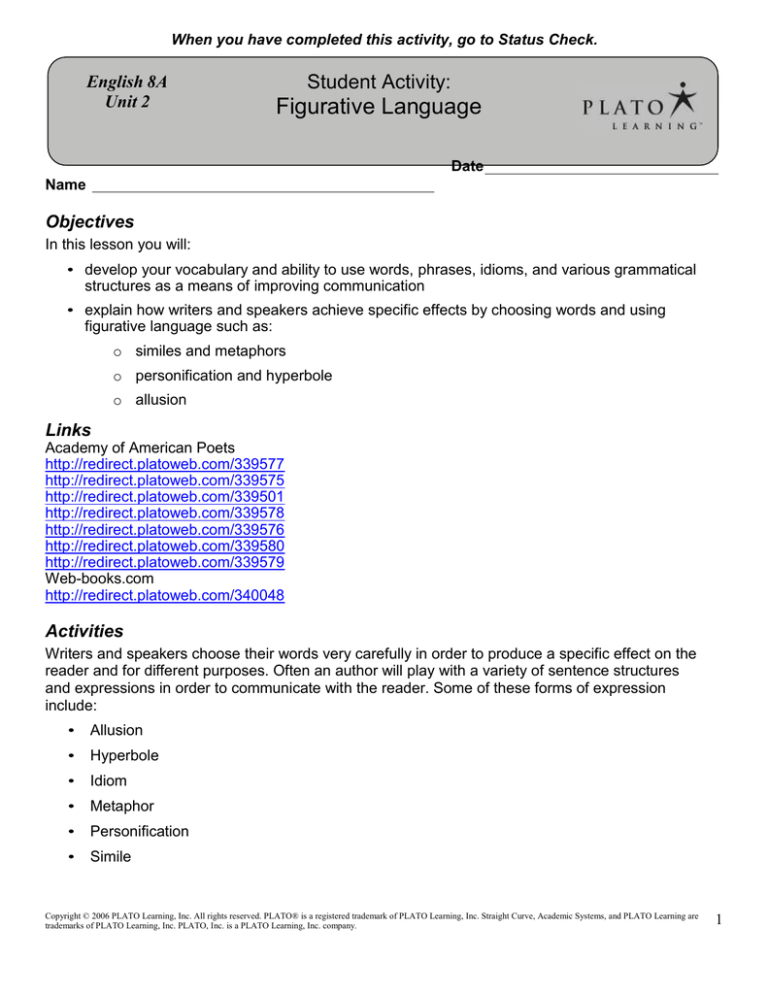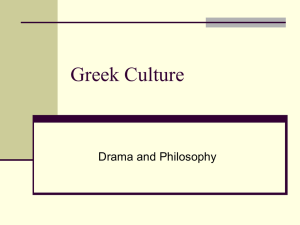
When you have completed this activity, go to Status Check.
English 8A
Unit 2
Student Activity:
Figurative Language
Date
Name
Objectives
In this lesson you will:
• develop your vocabulary and ability to use words, phrases, idioms, and various grammatical
structures as a means of improving communication
• explain how writers and speakers achieve specific effects by choosing words and using
figurative language such as:
o similes and metaphors
o personification and hyperbole
o allusion
Links
Academy of American Poets
http://redirect.platoweb.com/339577
http://redirect.platoweb.com/339575
http://redirect.platoweb.com/339501
http://redirect.platoweb.com/339578
http://redirect.platoweb.com/339576
http://redirect.platoweb.com/339580
http://redirect.platoweb.com/339579
Web-books.com
http://redirect.platoweb.com/340048
Activities
Writers and speakers choose their words very carefully in order to produce a specific effect on the
reader and for different purposes. Often an author will play with a variety of sentence structures
and expressions in order to communicate with the reader. Some of these forms of expression
include:
•
Allusion
•
Hyperbole
•
Idiom
•
Metaphor
•
Personification
•
Simile
Copyright © 2006 PLATO Learning, Inc. All rights reserved. PLATO® is a registered trademark of PLATO Learning, Inc. Straight Curve, Academic Systems, and PLATO Learning are
trademarks of PLATO Learning, Inc. PLATO, Inc. is a PLATO Learning, Inc. company.
1
How do poets use these literary techniques?
1. Allusion is an indirect or passing reference to something, usually intended to generate an
understanding of something else (He’s such a grinch!). Often, an author will make an allusion
to the work of another writer. Read the following poems and notice how Langston Hughes
refers to or alludes to Walt Whitman’s poem.
•
“I Hear America Singing,” by Walt Whitman
•
“I, Too, Sing America,” by Langston Hughes
Work in your group to answer these questions. Write your responses in the space provided.
What is Walt Whitman saying about America in his poem? What is Langston Hughes saying
about America in his poem? Why do you think Hughes alludes to the work of Whitman? How
does the use of allusion make Hughes’ poem more effective at communicating its message?
2. Hyperbole is obvious exaggeration for the purposes of effect. Read these examples:
• “Hey, Sally, I haven’t seen you in a million years!”
• “Those books weigh a ton.”
• “I’m hungry enough to eat a cow!”
Read Robert Frost’s poem “Stopping by Woods on a Snowy Evening”.
Locate an example of hyperbole in the poem, and write the line in the space provided. What
effect does hyperbole have on the reader?
Work with a partner and write your own sentences or compose a short poem using hyperbole.
Write your response in the space provided.
Copyright © 2006 PLATO Learning, Inc. All rights reserved. PLATO® is a registered trademark of PLATO Learning, Inc. Straight Curve, Academic Systems, and PLATO Learning are
trademarks of PLATO Learning, Inc. PLATO, Inc. is a PLATO Learning, Inc. company.
2
3. Metaphor is applying a word or phrase to a thing to which it is not literally applicable. Read
these examples of metaphor:
• “He lived every day in a forest of happiness.”
• “We could always depend on John, the rock of our family.”
Read the following Langston Hughes poems and find examples of metaphor. Write your
answer in the space provided.
• “I, Too, Sing America”
• “Dreams”
Now work with a partner and write five metaphors about the following themes: love, hate, life,
friendship, and a season (spring, summer, winter, or fall).
4. Simile is comparing one thing with another thing to create a literary effect, using “like” or “as.”
Read these examples of simile:
• “Winter came in like a lion.”
• “Her eyes were as blue as the sky.”
• “Stephanie was as sleepy as a newborn baby.”
Write several similes of your own. Then, share your examples with a partner or your reading
group.
Copyright © 2006 PLATO Learning, Inc. All rights reserved. PLATO® is a registered trademark of PLATO Learning, Inc. Straight Curve, Academic Systems, and PLATO Learning are
trademarks of PLATO Learning, Inc. PLATO, Inc. is a PLATO Learning, Inc. company.
3
Find examples of simile in the following poems. Write your answers below and then share
them with a partner or your reading group.
• “The Daffodils”, by William Wordsworth
• “Birches”, by Robert Frost
5. Personification is giving human characteristics to something non-human. Read these
examples:
• “The car snarled out its anger at having to be started on a cold morning.”
• “The wind whispered softly in my ear.”
• “The steep hill taunted my efforts as I raced to reach the top.”
Read the following poems and locate examples of personification in each. Record your
answers in the space provided, and then share them with a partner.
• “The Tide Rises, the Tide Falls”, by Henry Wadsworth Longfellow
• “The Walrus and the Carpenter”, by Lewis Carroll
Next, write a sentence about each of the following objects, using personification. Share your
sentences with a partner.
Moon
Flower
Bell
Telephone
Car
Copyright © 2006 PLATO Learning, Inc. All rights reserved. PLATO® is a registered trademark of PLATO Learning, Inc. Straight Curve, Academic Systems, and PLATO Learning are
trademarks of PLATO Learning, Inc. PLATO, Inc. is a PLATO Learning, Inc. company.
4
6. Writers also often use idioms in their works. An idiom is a phrase that, as an expression, has
a meaning that cannot be inferred simply from the words within (“kitty-corner,” “in the bag”).
We use idioms in our everyday language, but over time they may fall out of usage.
Visit Edward Lear’s poem “The Jumblies” and read line 9:
“But we don't care a button! We don't care a fig!”
What do you think Lear meant when he wrote this line? Write your response below.
Is the language or idiom Lear wrote still used commonly today? Write your answer below.
How would you say “I don’t care a button” or “I don’t care a fig”? What idioms do we have in
modern English that mean the same thing? Write your answer below.
Now share your answers with your group. How were your group members’ responses similar
to and different from your own? How many different ways of saying “I don’t care a button” or “I
don’t care a fig” did your group write?
Copyright © 2006 PLATO Learning, Inc. All rights reserved. PLATO® is a registered trademark of PLATO Learning, Inc. Straight Curve, Academic Systems, and PLATO Learning are
trademarks of PLATO Learning, Inc. PLATO, Inc. is a PLATO Learning, Inc. company.
5







